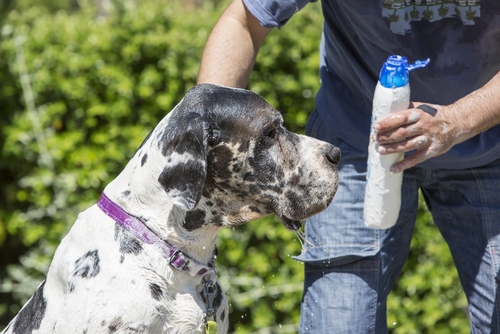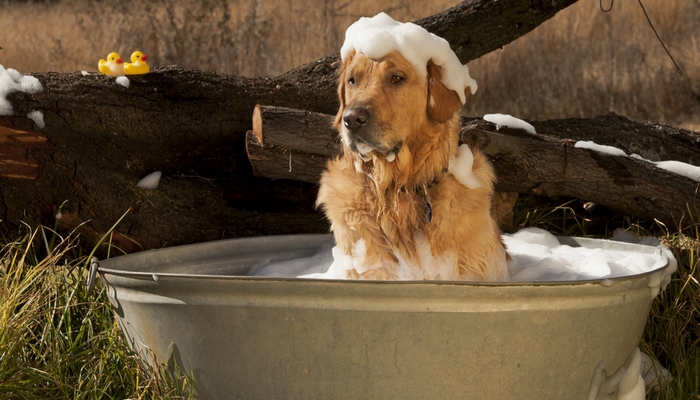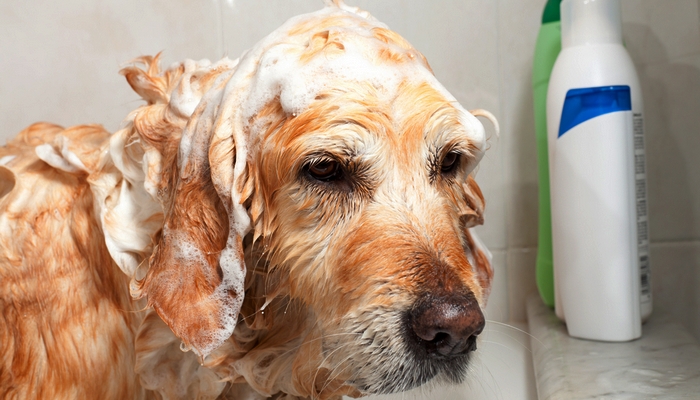Bathing your dog at home can save you time and money. No more trips to the groomers and no more expensive bills from the professionals! Learning how to make dog shampoo can save you even more money, and it's the best way to meet your dog's specific grooming needs.
The first thing you need to know is that you SHOULD be buying dog shampoo for your pooch. Human shampoo is made for our hair and our skin. It has a different pH level than shampoo that is made for canines.
As I discuss in my video guide, ensuring the proper pH is a major part of learning how to make dog shampoo. Human shampoo can do damage to your dog's coat and dry out his skin.
 Most commercial pet shampoos are full of toxins and chemicals that can do more damage to your pet than anything. They won't just effect his skin and coat; the toxins and chemicals contained in these grooming products can leach into your dog's body through his skin.
Most commercial pet shampoos are full of toxins and chemicals that can do more damage to your pet than anything. They won't just effect his skin and coat; the toxins and chemicals contained in these grooming products can leach into your dog's body through his skin.
Some of these chemicals have been linked to diseases like cancer!
If you want to ensure that your dog is healthy and happy, it's best to learn how to make dog shampoo. Even commercial products that claim to use “natural” ingredients aren't as safe as you think. Oftentimes they use a few natural extracts and the same chemicals and toxins as the other brands.
These companies dupe consumers into thinking that they are spending money on a healthy and safe product, when they're really buying the exact type of shampoo that they are trying to stay away from. Learning how to make dog shampoo is the only way to be 100% certain about the ingredients.
MORE VIDEOS: How-To Guides, Tips and Advice for Dog Owners
How To Make Dog Shampoo at Home
Now don't get me wrong, there are quality dog shampoos out there on the commercial market. They are made with natural, safe and healthy ingredients. I certainly don't mean to say that you can't find a safe dog shampoo anywhere on the market.
However, the quality dog grooming products available are much more expensive than the ones that are full of harmful ingredients. I know, why would the natural products cost more? It's definitely frustrating, but it is what it is.
That's why so many pet owners are looking into making their own homemade dog shampoo. It's not hard to do, and once you find a few recipes that you like you won't need to do anymore research.
MY REVIEW: Best Dog Shampoo and Top 10 Alternatives
How To Choose Shampoo Ingredients
 The first thing you'll need to decide is what type of dog shampoo that you need. Does your dog just need to be clean and smelling fresh? Does he have dry or itchy skin? Does he have long hair that needs a detangler?
The first thing you'll need to decide is what type of dog shampoo that you need. Does your dog just need to be clean and smelling fresh? Does he have dry or itchy skin? Does he have long hair that needs a detangler?
This is the best part about learning how to make dog shampoo. You can cater to your dog's needs and your preferences. Do you prefer a certain aroma? Maybe you want your dog to smell like citrus or lavender. You can use any essential oils that you like to leave a fresh scent on your canine companion.
Here's where it gets tricky. You need to understand pH in order to find the best dog shampoo recipes. While our skin has a pH of around 5.5 to 5.6, a dog's skin is much more neutral. Every breed's skin pH is a little different, but they average a pH of between 6.2 and 8.62.
The homemade dog shampoo that you make will need to have a pH level as close to your dog's skin pH as possible. You can purchase pH test strips online or in virtually every pet store. You can test your dog's skin over the course of a few days and take an average of the pH levels.
If the pH of your homemade dog shampoo is too high or too low it can cause skin irritation.
When you're learning how to make dog shampoo, you're going to mix acidic substances with alkaline substances in a neutral base, like water. Here are some of the pH levels of the most common ingredients in homemade dog shampoo:
- water (neutral) – 7
- baking soda (alkaline) – 8.3
- vinegar (acid) – 2.2
- lemon juice (acid) – 2.0
- dish soap (alkaline) – between 7 and 9
Other common ingredients in homemade dog shampoo include essential oils and oatmeal. Oatmeal can be used to soothe dry and itchy skin. Essential oils can be used for many things, but they are most commonly added as a natural flea and tick repellent and for their aroma.
RECOMMENDED READ: 5 Best Medicated Dog Shampoos for Dog's Skin Problems
Finding A Recipe That Works
Finding the right shampoo for your pet may involve some trial and error. When you mix a recipe for the first time, I suggest you only make a half batch. This way you can try it out, and if you don't like it you won't be wasting as much shampoo.
Finding a shampoo that will clean your dog and leave his skin and coat healthy is the top priority. Of course, you'll want a shampoo that leaves your skin feeling good too. You'll also want to choose one with a scent that is pleasant to you.
If you need any help, contact your veterinarian or a local groomer to discuss your concerns with your pup's grooming needs. After a quick meeting they'll be able to tell you more about your dog's specific grooming needs and what type of shampoo would be best for him.
Safe and Healthy Recipes for Dog Shampoo
If you're looking for some safe recipes to try, there are many different sites that you can go to. Just be sure that the site you select is a reputable one.
Here are some to get you started:
You can also read through some of the informative articles on our site. We share recipes for homemade shampoo as well as tips and tricks for buying quality commercial dog shampoo.
- How To Make Homemade Flea Shampoo for Dogs
- Benefits of Using Waterless Shampoo
- 4-Legger Certified Organic Shampoo for Dogs Review
- Eco Dog Care Anti-Itch Shampoo for Dogs Review
If you’re new to at-home dog grooming, watch my video guide on how to bathe a dog for help with this common grooming task. It’s easier than you may think.
Need more help with other types of dog care tips and advice? Check our YouTube channel.
FULL GUIDE: How To Bathe A Dog: A Step-By-Step Video Guide














